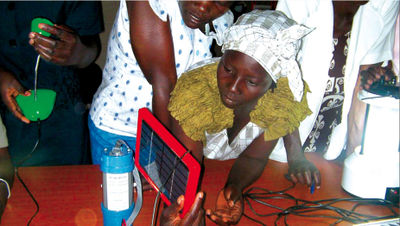Knowledge fuels change
For over a decade, Energypedia has shared free, reliable energy expertise with the world.
We’re now facing a serious funding gap.
Help keep this platform alive — your donation, big or small, truly matters!
Thank you for your support
Difference between revisions of "PicoPV Field Tests"
***** (***** | *****) m |
***** (***** | *****) m Tag: 2017 source edit |
||
| (2 intermediate revisions by one other user not shown) | |||
| Line 1: | Line 1: | ||
| − | + | [[Portal:Solar|►Back to Solar Portal]] | |
= Overview = | = Overview = | ||
More than 100 firms are offering PicoPV products in developing countries today<ref name="ii">GTZ. iidevelopment.2010. GTZ Solar Lamps Field Test Uganda.FINAL REPORT.</ref> and new products are introduced almost daily<ref>Sun connect.2010. Rural Electrification with Photovoltaics.</ref>. But most products are of very low quality, with serious implications for consumer trust in the new technology. Early lab tests have focused the awareness of governments and donors on the importance of quality control and customer information – however, field tests in sufficient countries with sufficient sample sizes are needed for a better understanding of PicoPV performance under real-life conditions, and to identify gaps in the emerging draft lab test procedures. Therefore, it is important to complement laboratory test with field tests. In addition, private sector actors lack basic market information on this new technology (such as national market potentials, local consumer preferences and willingness to pay) which they would need to decide if and how to enter this new market segment. | More than 100 firms are offering PicoPV products in developing countries today<ref name="ii">GTZ. iidevelopment.2010. GTZ Solar Lamps Field Test Uganda.FINAL REPORT.</ref> and new products are introduced almost daily<ref>Sun connect.2010. Rural Electrification with Photovoltaics.</ref>. But most products are of very low quality, with serious implications for consumer trust in the new technology. Early lab tests have focused the awareness of governments and donors on the importance of quality control and customer information – however, field tests in sufficient countries with sufficient sample sizes are needed for a better understanding of PicoPV performance under real-life conditions, and to identify gaps in the emerging draft lab test procedures. Therefore, it is important to complement laboratory test with field tests. In addition, private sector actors lack basic market information on this new technology (such as national market potentials, local consumer preferences and willingness to pay) which they would need to decide if and how to enter this new market segment. | ||
| Line 10: | Line 10: | ||
| − | *[[ | + | *[[PicoPV Consumer Survey|Instruments for Field Survey]] |
GIZ also developed various instruments in order to accomplish researches on consumer needs and impacts. These instruments are based on quantitative and qualitative methods. | GIZ also developed various instruments in order to accomplish researches on consumer needs and impacts. These instruments are based on quantitative and qualitative methods. | ||
| Line 33: | Line 33: | ||
*[[Portal:Solar|Solar Portal on energypedia]]<br/> | *[[Portal:Solar|Solar Portal on energypedia]]<br/> | ||
| − | |||
*[[PicoPV Systems: Costs, Financing, Business and Operation Models|Fiancing PicoPV]]<br/> | *[[PicoPV Systems: Costs, Financing, Business and Operation Models|Fiancing PicoPV]]<br/> | ||
*[[Features of PicoPV Systems|Features of PicoPV Systems]] | *[[Features of PicoPV Systems|Features of PicoPV Systems]] | ||
| Line 42: | Line 41: | ||
<references /> | <references /> | ||
| + | [[Category:PicoPV]] | ||
[[Category:Solar]] | [[Category:Solar]] | ||
| − | |||
Latest revision as of 12:23, 25 March 2022
Overview
More than 100 firms are offering PicoPV products in developing countries today[1] and new products are introduced almost daily[2]. But most products are of very low quality, with serious implications for consumer trust in the new technology. Early lab tests have focused the awareness of governments and donors on the importance of quality control and customer information – however, field tests in sufficient countries with sufficient sample sizes are needed for a better understanding of PicoPV performance under real-life conditions, and to identify gaps in the emerging draft lab test procedures. Therefore, it is important to complement laboratory test with field tests. In addition, private sector actors lack basic market information on this new technology (such as national market potentials, local consumer preferences and willingness to pay) which they would need to decide if and how to enter this new market segment.
Instruments for Field Survey
In order to help bridge these information gaps and support the development of the nascent PicoPV market, GIZ has launched a comprehensive PicoPV field test and survey in five developing countries across different continents, using a range of specially developed research tools.[1]
GIZ also developed various instruments in order to accomplish researches on consumer needs and impacts. These instruments are based on quantitative and qualitative methods.
In order to develop the market for PicoPV, it is important to fínd out more about consumer needs.
PicoPV Systems
► More information about the PicoPV technical test
► A specific example of technial test on solar lantern
Further Information




















